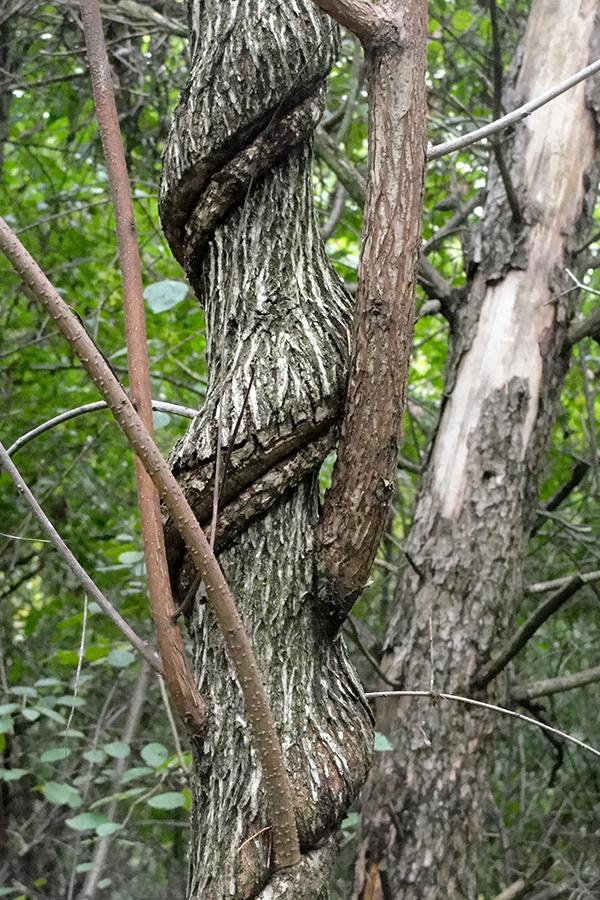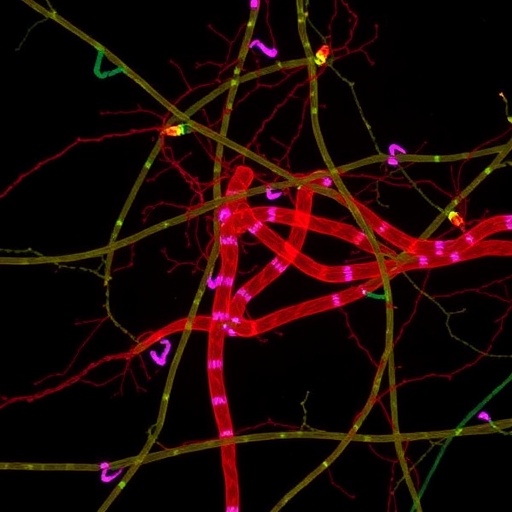
Credit: Photo by David Zaya
CHAMPAIGN, Ill. — Gardeners hoping to celebrate the beauty of American bittersweet – a native vine that produces orange berries in the fall and is used for wreaths – may be unwittingly buying an invasive bittersweet instead. That's because many Midwestern retailers are selling oriental bittersweet with labels misidentifying it as the native plant, researchers report. These sales are occurring in stores and online.
Unlike American bittersweet (Celastrus scandens), oriental bittersweet (Celastrus orbiculatus) is problematic because it grows aggressively, girdles saplings and smothers even mature trees with its abundant, leafy vines, said Illinois Natural History Survey plant ecologist David Zaya , who led the new research.
"Oriental bittersweet changes ecosystems, it changes forests," he said. "The vines can live for decades, and its seeds are spread by birds."
Oriental bittersweet also outcompetes American bittersweet by pollinating female flowers on the native plants, Zaya said. Almost all the hybrids are sterile, leading to a reproductive dead-end for the native plants.
"Meanwhile, oriental bittersweet almost never has hybrid seeds," he said.
The new findings, published in the journal Invasive Plant Science and Management, are the result of an investigation begun after Zaya heard reports of native bittersweet plants behaving strangely.
"When I was presenting at a conference, people told me they had bought American bittersweet but that it was going wild or was very aggressive," he said. "They thought it might be a hybrid, or that they had purchased the wrong species."
Zaya and his colleagues at the University of Illinois at Chicago and the U.S. Geological Survey decided to test bittersweet plants for sale in the Midwest to see if vendors were accurately identifying their plants. He bought 34 plants labeled "American bittersweet" from 11 vendors based in Indiana, Illinois, Missouri and Nebraska and compared them with wild, correctly identified bittersweet plants. He purchased the plants in stores and online.
When they're young, American and oriental bittersweet plants look almost identical, so Zaya developed microsatellite genetic markers to aid in identification. These markers occur in highly repetitive, noncoding regions of the DNA. Their diversity allows scientists to distinguish species and even varieties of the same species.
The analysis revealed that 54 percent of the purchased plants labeled "American bittersweet" and/or "Celastrus scandens" were in fact oriental bittersweet. Seven of the 11 vendors tested were selling mislabeled plants. Four of these were located in Illinois, where it is illegal to sell oriental bittersweet.
Some of the mislabeled plants had photographs of oriental bittersweet on their labels. Both species produce red berries, but oriental bittersweet berries have a bright yellow outer capsule, which is easily distinguishable from the orange capsule of American bittersweet berries, Zaya said.
"Some garden centers selling small plants are very plausibly making an honest mistake. But at some point along the supply chain, someone is being irresponsible or dishonest," he said.
Those hoping to purchase American bittersweet – and not its invasive cousin – will need to be particularly vigilant about what they're getting, Zaya said. It's easier to identify plants with flowers or berries (see photos), but most vendors sell plants that are too young to flower or fruit. Zaya recommends buying the plants in person, as nearly all of the bittersweet plants he bought online were invasives mislabeled as natives. He urges people to question retail managers about their suppliers and stock, to find out what steps they're taking to ensure they're selling the right plants.
"It's important to be persistent and don't give up until you have good reason to believe that they know what they're talking about," he said. "And if it has a picture with yellow berries, don't buy it – and please bring it to my attention so I can contact that seller."
###
The Illinois State Academy of Science and Chicago Wilderness funded this research.
The INHS is a division of the Prairie Research Institute at the University of Illinois.
Editor's notes:
To reach David Zaya, call 217-244-1946; email [email protected]
The paper "Mislabeling of an invasive vine (Celastrus orbiculatus) as a native congener (C. scandens) in horticulture" is available online and from the U. of I. News Bureau.
Media Contact
Diana Yates, Research Editor, Univ. of Illinois News Bureau
[email protected]
217-333-5802
@NewsAtIllinois
http://www.illinois.edu
Original Source
https://news.illinois.edu/view/6367/592230 http://dx.doi.org/10.1017/inp.2017.37






